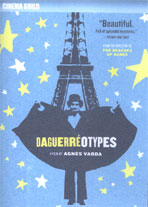
Daguerrotypes 1976
Distributed by Cinema Guild, 115 West 30th Street, Suite 800, New York, NY 10001; 212-685-6242
Produced by Ciné Tamaris, Institut National de l'Audiovisuel (INA), Zweites Deutsches Fernsehen (ZDF)
Directed by Agnes Varda
DVD, color, 80 min.
Sr. High - General Adult
European Studies, Film Studies, Social Sciences, Sociology, Women’s Studies
Date Entered: 08/26/2011
Reviewed by Jennifer Dean, MALS student, City University of New York (CUNY Graduate Center)In Daguerréotypes Agnes Varda, the “grandmother” of the French New Wave, captures the daily transactions of the local merchants and customers on the Rue Daguerre in Paris in 1975. Varda juxtaposes the fairly mundane exchanges with a performance by a local magician who introduces the film in a grandiose manner before the Eiffel Tower. Varda’s incredible talent for framing images is apparent in this otherwise simple and straightforward documentary of daily life. She reveals how the windows and doors of the markets frame both people and products while also utilizing her camera to frame the outside world. Although her other films, such as The Gleaners and I and The Beaches of Agnes, may tackle larger societal or philosophical issues, Daguerréotypes allows the viewer to embrace modernity through the lives of the vendeurs and consumers she introduces. At one point in the film she tells us in voice-over that there is a vast market just at the other end of the Rue Daguerre where politics reigns but “Ici rien!” (Here nothing!) She remarks, “on this side of Rue Daguerre, the pavement is neutral. Here no one cares for politics. No one talks about it. It’s bad for business.”
Although politics are not discussed, the personal as political is revealed. The mundane and the every day is imbued with philosophical significance through the introduction of characters both as they conduct their business and as they speak directly to the camera about their lives. The magic of the market is highlighted by the illusions performed by the magician; such as when he turns fire into money intercut with the baker kneading his dough (which will eventually garner him bank notes). Through the interlacing of the footage of the magician creating illusion and the commerce of the Rue Daguerre Varda’s command of the visual image conveys philosophical as well as aesthetic truths.
Ultimately, however, this film is about the characters of the Rue; Mrs. Blue Thistle, as Varda refers to her, the woman at the parfumerie who looks trapped within her little store, the young woman who dreams of being a star ice skater, the women on the street whom we overhear talking about aging. The film does not necessarily provide intimate portraits of these individual characters so much as it paints an intimate portrait of the Rue Daguerre itself. Daguerréotypes is a wonderful film to watch for exploring questions of modernity, as a companion piece to the Maysles’ brothers’ Salesman, or for anyone interested in the intricacies of editing and framing the cinematic image.